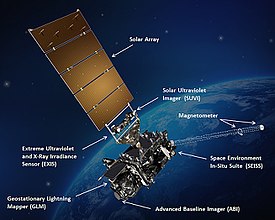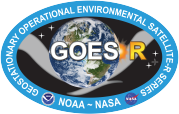GOES-16
| 此條目翻譯品質不佳。 (2019年5月14日) |
坐标:0°00′N 75°12′W / 0°N 75.2°W
 艺术家对GOES-16在轨道上的想象图 | |||||||||||||||
| 名称 | GOES-R (before 29 November 2016) | ||||||||||||||
|---|---|---|---|---|---|---|---|---|---|---|---|---|---|---|---|
| 任务类型 | 地球静止轨道 气象卫星 | ||||||||||||||
| 运营方 | NASA/NOAA | ||||||||||||||
| 国际卫星标识符 | 2016-071A | ||||||||||||||
| 衛星目錄序號 | 41866 | ||||||||||||||
| 网站 | www | ||||||||||||||
| 任務時長 | 预计: 15 年 运行时间: 7年,4个月,15天 | ||||||||||||||
| 航天器属性 | |||||||||||||||
| 平台 | 洛克希德·马丁 A2100 | ||||||||||||||
| 制造方 | 洛克希德·马丁 | ||||||||||||||
| 發射質量 | 5,192公斤(11,446磅) | ||||||||||||||
| 乾質量 | 2,857公斤(6,299磅) | ||||||||||||||
| 尺寸 | 6.1乘5.6乘3.9米(20乘18乘13英尺) | ||||||||||||||
| 功率 | 4 千瓦 | ||||||||||||||
| 任務開始 | |||||||||||||||
| 發射日期 | 2016年10月19日23时42分UTC | ||||||||||||||
| 运载火箭 | 宇宙神5号 541 (AV-069) | ||||||||||||||
| 發射場 | 卡纳维拉尔角 SLC-41 | ||||||||||||||
| 承包方 | 联合发射联盟 | ||||||||||||||
| 運營開始時間 | 2017年10月18日 | ||||||||||||||
| 軌道參數 | |||||||||||||||
| 参照系 | 地心轨道 | ||||||||||||||
| 軌域 | 地球静止轨道 | ||||||||||||||
| 經度 | 西经75.2° | ||||||||||||||
| 槽位 | GOES East (after 18 December 2017) | ||||||||||||||
| 半長軸 | 42,164.8 km(26,200.0 mi) | ||||||||||||||
| 離心率 | 0.0001538 | ||||||||||||||
| 近地點 | 35,780.2 km(22,232.8 mi) | ||||||||||||||
| 遠地點 | 35,793.1 km(22,240.8 mi) | ||||||||||||||
| 傾角 | 0.0363° | ||||||||||||||
| 週期 | 1,436.1 分钟 | ||||||||||||||
| 曆元 | 2018年4月1日, 18:22:45[1] | ||||||||||||||
| |||||||||||||||
 GOES-R 使命徽章 | |||||||||||||||
GOES-16(在到达地球静止轨道之前被称为GOES-R、在到达地球静止轨道之后被称为GOES-East)是由NASA和NOAA运营的GOES-NEXT系列静止环境观测卫星中的第一颗。GOES-16是地球静止轨道气象卫星,定点于75.2°W,对美洲地区进行观测。GOES-16提供16个不同波段的高时间和空间分辨率的地球图像,此外,GOES-16还携带有四种观测太空环境和太阳的仪器。
GOES-16的设计开始于1999年,用于满足未来NOAA卫星的要求,经过10年的仪器设计,最终交付给洛克希德·马丁公司进行制造。2008年,GOES-16开始建造,并在2012-2014年进行不断的测试,在几经发射推迟之后,GOES-16于2016年11月19日在卡纳维拉尔角由ULA的宇宙神5号发射升空。几天后,卫星到达初始预定位置,并开始长达一年的验证实验阶段。2017年11月,GOES-16向东移动到75.2°W,并于2017年12月18日宣布正式投入使用。GOES-16预计在轨运行10年,之后为后续GOES系列卫星提供5年在轨备份服务。
背景[编辑]
卫星仪器设计[编辑]
静止环境观测卫星(GOES)项目始于美国国家航空航天局(NASA)和国家海洋和大气管理局(NOAA)于1975年开发的地球静止轨道气象卫星继1966年开发的应用技术卫星和同步气象卫星项目。[2]
GOES-16的更多开发始于1999年6月NESDIS的ABI成像仪的设计,一开始设计时设计是一共有10个波段被加入ABI成像仪,并在卫星上添加6种不同仪器。[3][4]1999年9月,NOAA研究与发展理事会赞同继续发展该仪器的波段数量即频率带宽。[5] 随着仪器的进一步完善,波段的数量从最初的10个逐渐增长至1999年12月的12个。[3]除了ABI成像仪之外,还一并开始了先进基线测深仪(ABS)的开发,它将成为下一代GOES系列卫星高光谱环境套件(HES)的一部分。 和ABI一样,HES的分辨率和空间覆盖范围也明显扩大。[6]最初的设想是2018年ABI将作为GOES系列推出的GOES-Q开始搭载。[7]
在2011年,NOAA计划将于2012年启动GOES-R系列并发射GOES-R卫星,其中ABI和ABS都是设计搭载的仪器。GOES-R和其系列卫星将向用户提供新的业务产品,提高气象预报的细节及准确性。[8]四年后,ABI的波段数增加至16个,覆盖范围包括可见光、近红外和红外线。[9]在2006年9月,NOAA放弃了HES及GOES-R在内的计划,理由是NPOESS没有足够的测试和开发中的严重成本超支。[10]对于预期的62亿美元来说,到2006年成本已经超支114亿美元。[11]
建造[编辑]
2008年12月,NASA和NOAA选定洛克希德·马丁航天系统为GOES-R及前两颗卫星的承包商,合同预计价值为10.9亿美元。[12] 初步设计于两年后完成[13] ,最终设计于2012年5月完成[14]。卫星建造平台外包给ATK公司,核心部件于2013年1月交付[15]。2013年5月,极端紫外线和X射线辐射传感器(EXIS)成为第一个安装就绪的Go-R仪器[16]。ABI于2014年2月完成一体化[17]。3个月后交付了航天器推进和系统模块,并完成最后的集成和测试阶段[18]。卫星其后被转移至肯尼迪航天中心并在2016年8月22日后进行更多实验并为发射做出准备[19]。
航天器设计[编辑]
| 波长 | 編號 | 簡稱 | 中心波長 (µm) |
赤道帶 水平解析度 (km) |
偵測範疇 |
|---|---|---|---|---|---|
| 可見光 | 1 | V1 | 0.470 | 1 | 植被、氣膠、彩色圖像(藍) |
| 2 | VS | 0.640 | 0.5 | 植被、低雲與霧、彩色圖像(紅) | |
| 近紅外線 | 3 | N1 | 0.860 | 1 | 植被、氣膠 |
| 4 | N2 | 1.380 | 2 | 卷云 | |
| 5 | N3 | 1.610 | 1 | 雪/冰识别,云相态 | |
| 6 | N4 | 2.260 | 2 | 雲密度半徑範圍 | |
| 紅外線 | 7 | I4 | 3.90 | 2 | 低雲族與霧、自然火災 |
| 8 | WV | 6.15 | 2 | 對流層高层水汽 | |
| 9 | W2 | 7.00 | 2 | 對流層中层水汽 | |
| 10 | W3 | 7.40 | 2 | 对流层低层水汽 | |
| 11 | MI | 8.50 | 2 | 雲相判別、二氧化硫 | |
| 12 | O3 | 9.70 | 2 | 臭氧含量 | |
| 13 | IR | 10.30 | 2 | 雲圖像、雲頂資訊 | |
| 14 | L2 | 11.20 | 2 | 雲圖像、海面溫度 | |
| 15 | I2 | 12.30 | 2 | 雲圖像、海面溫度 | |
| 16 | CO | 13.30 | 2 | 雲頂高度 |
参考文献[编辑]
- ^ GOES-R - Orbit. Heavens-Above. 1 March 2018 [4 March 2018]. (原始内容存档于2018-03-04).
- ^ Dunbar, Brian. Lynn, Jenner , 编. GOES Overview and History. GOES Satellite Network. NASA. 3 August 2017 [10 April 2018]. (原始内容存档于2020-09-28).
- ^ 3.0 3.1 CIMSS GOES Activities. Cooperative Institute for Meteorological Satellite Studies. University of Wisconsin-Madison. 5 May 2011 [10 April 2018]. (原始内容存档于2020-10-27). 引证错误:带有name属性“CIMSSGooesActivities”的
<ref>标签用不同内容定义了多次 - ^ Schmit, Tim. Tim Schmit. NOAA Satellites and Information. University of Wisconsin-Madison. 14 March 2017 [10 April 2018]. (原始内容存档于2020-09-28).
- ^ Schmit, Tim; Menzel, Paul. Spectral Band Selection for the Advanced Baseline Imager (ABI) (PPT) (报告). University of Wisconsin-Madison. September 1999 [10 April 2018]. (原始内容存档于2020-10-27).
- ^ Schmit, Timothy J.; Li, Jun; Gurka, James. Introduction of the Hyperspectral Environmental Suite (HES) on GOES-R and beyond (PDF). University of Wisconsin-Madison. November 2003 [2019-04-21]. (原始内容存档 (PDF)于2020-10-28).
- ^ Schmit, Tim; Menzel, Paul; Woolf, Hal; Gunshor, Mat; Baum, Bryan; Sisko, Chris; Huang, Allen; Wade, Gary; Bachmeier, Scott; Gumley, Liam; Strabala, Kathy. Spectral Band Selection for the Advanced Baseline Imager (ABI) (PDF) (报告). University of Wisconsin-Madison. February 2000 [10 April 2018]. (原始内容存档 (PDF)于2020-10-18).
- ^ GOES Users' Conference (PDF) (Conference Report). NASA. 22–24 May 2001 [10 April 2018]. (原始内容存档 (PDF)于2017-05-13).
- ^ Schmit, Timothy J.; Gunshor, Mathew M.; Menzel, W. Paul; Gurka, James J.; Li, Jun; Bachmeier, A. Scott. Introducing the Next-Generation Advanced Baseline Imager on GOES-R. Bulletin of the American Meteorological Society. August 2005, 86 (8): 1079–1096. Bibcode:2005BAMS...86.1079S. doi:10.1175/BAMS-86-8-1079.
- ^ Iannotta, Ben. NOAA Drops GOES-R Sensors. Space.com. 18 September 2006 [10 April 2018]. (原始内容存档于2020-08-14).
- ^ Singer, Jeremy. NOAA Tells Congress GOES R Cost Nearly Double Previous Estimate. SpaceNews. 3 October 2006 [10 April 2018]. (原始内容存档于2019-10-16).
- ^ Cole, Steve; O'Carroll, Cynthia; Leslie, John. NASA Selects NOAA Goes-R Series Spacecraft Contractor. NASA. 2 December 2008 [10 April 2018]. (原始内容存档于2020-10-27).
- ^ Lockheed Martin Team Completes Goes-R Weather Satellite Preliminary Design Review. Lockheed Martin. 1 February 2011 [10 April 2018]. (原始内容存档于2017-03-14).
- ^ Lockheed Martin Completes GOES-R Weather Satellite Critical Design Review. Lockheed Martin. 1 May 2012 [10 April 2018]. (原始内容存档于2017-03-13).
- ^ Lockheed Martin Delivers GOES-R Weather Satellite Core Structure for Propulsion System Integration. Lockheed Martin. 7 January 2013 [10 April 2018]. (原始内容存档于2016-06-04).
- ^ First GOES-R instrument ready to be installed onto spacecraft. NOAA. 2 May 2013 [10 April 2018]. (原始内容存档于2016-12-16).
- ^ Exelis Delivers GOES-R Instrument to Lockheed. SpaceNews. 17 February 2014 [10 April 2018]. (原始内容存档于2019-10-16).
- ^ GOES-R Weather Satellite Modules Delivered To Lockheed Martin. Lockheed Martin. 1 May 2014 [10 April 2018]. (原始内容存档于2016-06-03).
- ^ NOAA's GOES-R Arrives at NASA Kennedy for Launch Processing. NASA. 23 August 2016 [10 April 2018]. (原始内容存档于2020-09-18).
